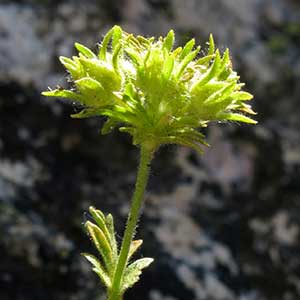Ivesia sect. Ivesia
Ivesia longibracteata
Castle Crags ivesia, longbract mousetail
(0.2–)0.3–2(–4) dm.
ascending to erect, 0.3–1.2 dm.
usually loosely to very tightly cylindric (mousetail-like in I. muirii), rarely weakly planar (I. longibracteata);
stipules present;
leaflets overlapping, individually distinguishable or not, lobed to base, sparsely to densely hairy, sometimes glabrous or glabrate;
terminal leaflets indistinct.
weakly planar to loosely ± cylindric, (0.5–)2–4(–6) cm; sheathing base glandular abaxially, otherwise glabrous;
petiole 0.5–2 cm, hairs 0.2–1 mm;
leaflets 5–6 per side, 2–6 mm, ± short-hirsute, glandular-puberulent, lobes 2–7, oblanceolate to spatulate or obovate, apex not setose.
(0–)1–3, sometimes paired;
blade usually ± reduced to vestigial, rarely well developed.
1–3, not paired.
usually ± congested, sometimes becoming open in fruit, flowers mostly arranged in 1–few(–several in I. gordonii var. wasatchensis) loose to capitate glomerules.
3–14-flowered, 1–2.5 cm diam.;
glomerules 1.
remaining straight.
1.5–6 mm.
hypanthium shallowly cupulate or campanulate, sometimes turbinate (I. gordonii);
petals not medially reflexed, golden to pale yellow, sometimes white (I. utahensis) and then sometimes pink-tinged, not or scarcely clawed, apex acute to truncate, rounded, or emarginate;
stamens 5 (10 in I. pygmaea), anthers longer than wide, laterally dehiscent;
carpels (1–)2–15(–30 in I. pygmaea).
8–10 mm diam.;
epicalyx bractlets linear to narrowly lanceolate or elliptic, 2.5–5 mm, longer than sepals;
hypanthium shallowly cupulate, 0.5–1 × 2–3 mm;
sepals 1.5–2.5 mm, ± acute;
petals pale yellow, linear to narrowly oblanceolate, 1.5–2.5 mm;
stamens 5, filaments 0.7–1.3 mm, anthers yellow, 0.5–0.8 mm;
carpels 6–11, styles 1–1.5 mm.
vertical, smooth or nearly so, not carunculate.
cream to light tan, 1.2–1.5 mm.
Ivesia sect. Ivesia
Ivesia longibracteata
Species 8 (8 in the flora).
Species in sect. Ivesia tend to form compact rosettes or tufts in open montane to alpine areas, often where rocky but generally not growing in rock crevices (except Ivesia longibracteata). General characteristics of the section are an overall evident glandularity, loosely to tightly cylindric leaves (mousetail-like in I. muirii), relatively short ascending to erect stems, straight pedicels, and flowers that are typically congested into 1–few capitate clusters that sometimes become more open in fruit. The taproots of some species, especially I. lycopodioides, are markedly enlarged, an adaptation to alpine growing conditions. The inclusion of two anomalous species in the section, I. longibracteata and I. webberi, is tentative; it is also possible that I. cryptocaulis belongs here rather than in sect. Setosae.
Section Ivesia has its center of species diversity in the high Sierra Nevada of California, where Ivesia pygmaea, with its ten stamens and more open habit, is possibly transitional between sects. Ivesia and Setosae. Ivesia gordonii (the most widespread species), I. tweedyi, and I. utahensis form an arc around the northern Great Basin, as outliers from the core Sierran distribution of the section.
Some early floras treated Ivesia pygmaea and I. lycopodioides as varieties of I. gordonii (for example, W. H. Brewer et al. 1876–1880, vol. 1) or Potentilla gordonii (Hooker) Greene (W. L. Jepson [1923–1925], 1909–1943, vol. 2). Recent treatments follow D. D. Keck (1938) in recognizing all three as distinct species; some annotations and references are nevertheless carried over from the earlier expanded circumscription of I. gordonii.
Since Ivesia cryptocaulis is sometimes identified as a member of sect. Ivesia, it is included herein and keys out in the seventh couplet.
(Discussion copyrighted by Flora of North America; reprinted with permission.)
Of conservation concern.
Ivesia longibracteata is known only from the Castle Crags area of Shasta County. The epithet alludes to a diagnostic characteristic unique in the genus: the epicalyx bractlets are longer than the sepals. The plants grow on vertical rock faces, a habitat more characteristic of sect. Setosae; however, the stems are ascending to erect and do not form hanging clumps, and the pedicels are not curved in fruit.
(Discussion copyrighted by Flora of North America; reprinted with permission.)
1. Epicalyx bractlets longer than sepals, 2.5–5 mm; leaves weakly planar to loosely ± cylindric; leaflets 5–6 per side; Castle Crags, n California. | I. longibracteata |
1. Epicalyx bractlets shorter than sepals, 0.5–3(–4 in I. gordonii) mm; leaves loosely to tightly cylindric; leaflets mostly 10–40 per side (4–10 in I. webberi); w United States | → 2 |
2. Plants silvery; leaves very tightly cylindric (mousetail-like, with leaflets scarcely distinguishable); leaflets 0.4–1 mm. | I. muirii |
2. Plants ± green; leaves loosely to tightly cylindric; leaflets distinguishable, (0.5–)2–13(–18) mm | → 3 |
3. Cauline leaves 2, paired; basal leaves: leaflets 4–8(–10) per side; petiole hairs 2–4 mm. | I. webberi |
3. Cauline leaves 0–2(–3), not paired; basal leaves: leaflets (6–)10–35 per side; petiole hairs 0.2–1.5 mm | → 4 |
4. Hypanthia turbinate to campanulate, (1.5–)2–4(–4.5) mm (± as deep as wide); petals narrowly oblanceolate to narrowly spatulate. | I. gordonii |
4. Hypanthia shallowly cupulate or shallowly campanulate, 1–2 mm (wider than deep); petals oblanceolate or broadly elliptic to spatulate or broadly obovate | → 5 |
5. Carpels (1–)2–6(–9); Idaho, Utah, Washington | → 6 |
5. Carpels (5–)8–30; e California, Nevada | → 7 |
6. Petals white, sometimes pink-tinged; stems prostrate to ascending; leaflets 2–4 mm; Utah. | I. utahensis |
6. Petals golden yellow; stems ascending to erect; leaflets 4–7(–10) mm; n Idaho, Washington. | I. tweedyi |
7. Plants diffusely matted; Spring Mountains, s Nevada. | I. cryptocaulis |
7. Plants rosetted to tufted or ± tightly matted; Sierra Nevada, White Mountains, and Sweetwater Mountains of e California and adjacent w Nevada | → 8 |
8. Stamens 10; sheathing bases usually ± strigose abaxially; taproots stout, not fleshy. | I. pygmaea |
8. Stamens 5; sheathing bases glabrous abaxially; taproots fusiform, fleshy. | I. lycopodioides |
